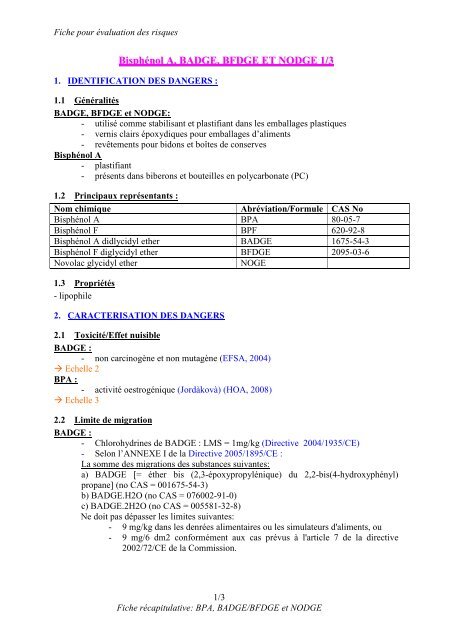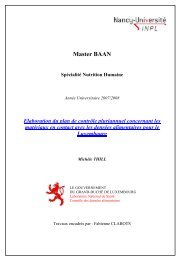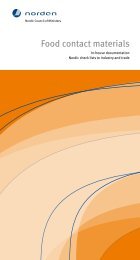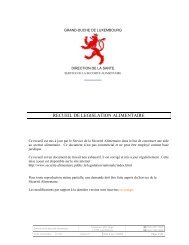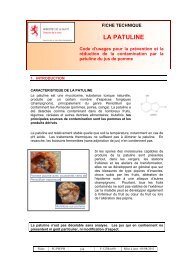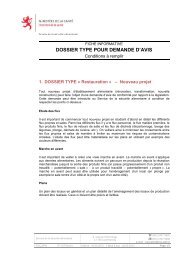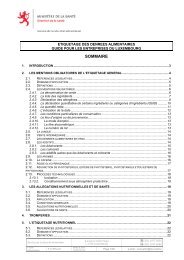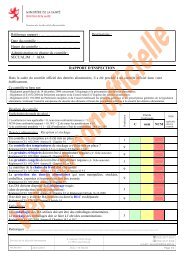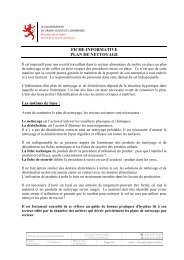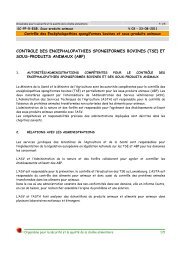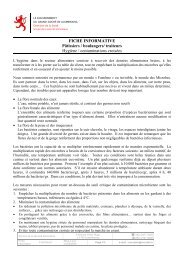Bisphénol A-BADGE-BFDGE-NODGE
Bisphénol A-BADGE-BFDGE-NODGE
Bisphénol A-BADGE-BFDGE-NODGE
You also want an ePaper? Increase the reach of your titles
YUMPU automatically turns print PDFs into web optimized ePapers that Google loves.
Fiche pour évaluation des risques<br />
<strong>Bisphénol</strong> A, <strong>BADGE</strong>, <strong>BFDGE</strong> ET <strong>NODGE</strong> 1/3<br />
1. IDENTIFICATION DES DANGERS :<br />
1.1 Généralités<br />
<strong>BADGE</strong>, <strong>BFDGE</strong> et <strong>NODGE</strong>:<br />
- utilisé comme stabilisant et plastifiant dans les emballages plastiques<br />
- vernis clairs époxydiques pour emballages d’aliments<br />
- revêtements pour bidons et boîtes de conserves<br />
<strong>Bisphénol</strong> A<br />
- plastifiant<br />
- présents dans biberons et bouteilles en polycarbonate (PC)<br />
1.2 Principaux représentants :<br />
Nom chimique<br />
Abréviation/Formule CAS No<br />
<strong>Bisphénol</strong> A BPA 80-05-7<br />
<strong>Bisphénol</strong> F BPF 620-92-8<br />
<strong>Bisphénol</strong> A didlycidyl ether <strong>BADGE</strong> 1675-54-3<br />
<strong>Bisphénol</strong> F diglycidyl ether <strong>BFDGE</strong> 2095-03-6<br />
Novolac glycidyl ether<br />
NOGE<br />
1.3 Propriétés<br />
- lipophile<br />
2. CARACTERISATION DES DANGERS<br />
2.1 Toxicité/Effet nuisible<br />
<strong>BADGE</strong> :<br />
- non carcinogène et non mutagène (EFSA, 2004)<br />
Echelle 2<br />
BPA :<br />
- activité oestrogénique (Jordàkovà) (HOA, 2008)<br />
Echelle 3<br />
2.2 Limite de migration<br />
<strong>BADGE</strong> :<br />
- Chlorohydrines de <strong>BADGE</strong> : LMS = 1mg/kg (Directive 2004/1935/CE)<br />
- Selon l’ANNEXE I de la Directive 2005/1895/CE :<br />
La somme des migrations des substances suivantes:<br />
a) <strong>BADGE</strong> [= éther bis (2,3-époxypropylénique) du 2,2-bis(4-hydroxyphényl)<br />
propane] (no CAS = 001675-54-3)<br />
b) <strong>BADGE</strong>.H2O (no CAS = 076002-91-0)<br />
c) <strong>BADGE</strong>.2H2O (no CAS = 005581-32-8)<br />
Ne doit pas dépasser les limites suivantes:<br />
- 9 mg/kg dans les denrées alimentaires ou les simulateurs d'aliments, ou<br />
- 9 mg/6 dm2 conformément aux cas prévus à l'article 7 de la directive<br />
2002/72/CE de la Commission.<br />
1/3<br />
Fiche récapitulative: BPA, <strong>BADGE</strong>/<strong>BFDGE</strong> et <strong>NODGE</strong>
Fiche pour évaluation des risques<br />
La somme des migrations des substances suivantes:<br />
a) <strong>BADGE</strong>.HCl (no CAS = 013836-48-1)<br />
b) <strong>BADGE</strong>.2HCl (no CAS = 004809-35-2)<br />
c) <strong>BADGE</strong>.H2O.HCl (no CAS = 227947-06-0)<br />
Ne doit pas dépasser les limites suivantes:<br />
- 1 mg/kg dans les denrées alimentaires ou les simulateurs d'aliments, ou<br />
- 1 mg/6 dm2 conformément aux cas prévus à l'article 7 de la directive<br />
2002/72/CE.<br />
DJA: <strong>BADGE</strong>: 0.15 mg/kg de poids corporals<br />
<strong>BFDGE</strong> et <strong>NODGE</strong> :<br />
Leur utilisation et leur présence ne sont plus autorisées à partir du 1er janvier 2005<br />
conformément à la directive 2002/16/CE. Il y a cependant lieu d'autoriser l'écoulement des<br />
stocks existants.<br />
BPA :<br />
LMS = 0.6 mg/kg<br />
3. EVALUATION DE L’EXPOSITION<br />
3.1 Occurrence dans la population (O)<br />
<strong>BADGE</strong>:<br />
• Observée :<br />
- Migrations entre 1.49.*10 -3 et 3.67 mg/dm 2 (Jordakova)<br />
- Pas souvent détecté<br />
Echelle 2<br />
BPA<br />
• Observée :<br />
- Migrations entre 0.63*10 -3 et 0.34 mg/dm 2 (Jordakova)<br />
- Pas souvent détecté<br />
Echelle 2<br />
3.2 Contribution à la contamination totale (C) - Exposition :<br />
<strong>BADGE</strong>:<br />
Echelle 2<br />
BPA<br />
<strong>Bisphénol</strong> A dans les biberons en polycarbonate : population à risque<br />
Echelle 4<br />
3.3 Niveau de confiance (NC) = Effet nuisible + (Occurence x Contribution)<br />
<strong>BADGE</strong>:<br />
NC = 2 + (2x2) = 6<br />
NC = 90 %<br />
BPA:<br />
NC = 3 + (2x4) = 11<br />
NC = 95 %<br />
3.4 Niveau de prévalence à contrôler (NPC)<br />
<strong>BADGE</strong>:<br />
Niveau 2 : Risque probablement sérieux : NPC = 5%<br />
BPA<br />
2/3<br />
Fiche récapitulative: BPA, <strong>BADGE</strong>/<strong>BFDGE</strong> et <strong>NODGE</strong>
Fiche pour évaluation des risques<br />
Niveau 3 : Risque sérieux : NPC = 2,5%<br />
4. CARACTERISATION DES RISQUES<br />
4.1 Le Marché luxembourgeois :<br />
<strong>BADGE</strong>:<br />
- pas de producteur concerné, ni de distributeur<br />
BPA :<br />
- pas de producteurs<br />
Prélèvement d’échantillons ¨dans les grandes surfaces au Luxembourg pour le <strong>BADGE</strong> et le<br />
BPA.<br />
Prélèvement d’échantillons dans des pharmacies et les 5 supermarchés pour le BPA<br />
- Biberons en PC : 35 échantillons différents<br />
4.2 Nombre d’échantillons à tester<br />
Selon WinEpiscope :<br />
- Biberons en PC : 29 échantillons différents à prélever<br />
4.3 Méthode d’analyse :<br />
<strong>BADGE</strong>:<br />
50 ml de simulant A (H 2 O), B (acide acétique 3%) et C (éthanol 10%) pendant 10 jours à<br />
40°C puis analyse par GC-MS (JORDÁKOVÁ)<br />
<strong>Bisphénol</strong> A<br />
50 ml de simulant A (H 2 O), B (acide acétique 3%) et C (éthanol 10%) pendant 10 jours à<br />
40°C puis analyse par GC-MS (JORDÁKOVÁ)<br />
Références<br />
- JORDÁKOVÁ, I. et al., Determination of Bisphenol A, Bisphenol F, Bisphenol A Diglycidyl Ether and Bisphenol F<br />
Diglycidyl Ether Migrated from Food Cans using Gas Chromatography-Mass Spectrometry, Czech J. Food Sci., Volume<br />
21, No. 3, p.85-902<br />
- EFSA, Opinion of the Scientific Panel on Food Additives, Flavoiruin Processing Aids and Material in Contact with<br />
Food an a request from the Commission related to 2,2-bis(4-hydroxyphenyl)propane bis(2,3-epoxypropyl)ether, The<br />
EFSA Journal, (2004), Volume 86.<br />
- HOA, H. et al, Bisphenol A is released from polycarbonate drinking bottles and mimics the neurotoxic actions of<br />
estrogen in developing cerebella neurons, Toxicology Letters, Volume 176, 2008, p149-156<br />
- SCF, Statement of the Scientific Committee an Food on Bisphenol A diglycidyl ether (<strong>BADGE</strong>), December 2002, 4 p.<br />
3/3<br />
Fiche récapitulative: BPA, <strong>BADGE</strong>/<strong>BFDGE</strong> et <strong>NODGE</strong>


